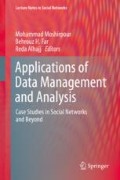Abstract
Visualization is an important part of network analysis. It helps to find features of the network that are not easily identifiable. Graph data visualization tries to enable users to grasp difficult concepts or identify new patterns. One of the problems that prevents users from achieving this goal is the crossing number of a graph drawing. A crossing in graph data visualization is a point where two curves intersect. In the minimum crossing number problem, the goal is to find a drawing of G with minimum number of edge crossings. In particular, except for a few initial cases, the crossing number of graphs remains unknown. Circular layout is one of the graph drawing algorithms that is used for visualizing graph datasets. In this research we tried to minimize the number of edge crossings in a circular layout using genetic algorithm. The result is promising.
Access this chapter
Tax calculation will be finalised at checkout
Purchases are for personal use only
References
Wasserman, S., & Faust, K. (1994). Social network analysis: Methods and applications (1sted.). Cambridge, New York: Cambridge University Press.
Chonbodeechalermroong, A., & Hewett, R. (2017). Towards visualizing big data with large-scale edge constraint graph drawing. Big Data Research, 10(Supplement C), 21–32.
Herman, I., Melançon, G., & Marshall, M. S. (2000). Graph visualization and navigation in information visualization: A survey. IEEE Transactions on Visualization and Computer Graphics, 6(1), 24–43.
Garey, M., & Johnson, D. (1983). Crossing number is NP-complete. SIAM Journal on Algebraic Discrete Methods, 4(3), 312–316.
Masuda, S., Kashiwabara, T., Nakajima, K., & Fujisawa, K. On the NP-completeness of a computer network layout problem [Online]. Retrieved October 13, 2017, from https://www.researchgate.net/publication/247043450_On_the_NP-completeness_of_a_computer_ network_layout_problem.
Bachmaier, C., Buchner, H., Forster, M., & Hong, S.-H. (2010). Crossing minimization in extended level drawings of graphs. Discrete Applied Mathematics, 158(3), 159–179.
Brandenburg, F. J. (1997). Graph clustering I: Cycles of cliques. In G. DiBattista (Ed.), Graph drawing. GD 1997. Lecture notes in computer science (Vol. 1353). Berlin: Springer.
Doğrusöz, U., Madden, B., & Madden, P. (1997). Circular layout in the Graph Layout toolkit. In S. North (Ed.), Graph drawing. GD 1996. Lecture notes in computer science (Vol. 1190). Berlin: Springer.
Six, J. M., & Tollis, I. G. (2006). A framework and algorithms for circular drawings of graphs. Journal of Discrete Algorithms, 4(1), 25–50.
Six, J. M., & Tollis, I. G. (1999). Circular drawings of biconnected graphs. In Selected papers from the International Workshop on Algorithm Engineering and Experimentation (pp. 57–73). London, UK.
Csardi, G., & Nepusz, T. (2006). The igraph software package for complex network research. InterJournal, Complex Systems, 1695, 1–9.
Tamassia, R. (Ed.). (2013). Handbook of graph drawing and visualization (1st ed.). New York: Chapman and Hall/CRC.
Kokosiński, Z., Kołodziej, M., & Kwarciany, M. (2004). Parallel genetic algorithm for graph coloring problem. In International Conference on Computational Science—ICCS 2004. LNCS 3036 (pp. 215–222).
Lipowski, A., & Lipowska, D. (2012). Roulette-wheel selection via stochastic acceptance. Physica A: Statistical Mechanics and its Applications, 391(6), 2193–2196.
Mitchell, M. (1998). An introduction to genetic algorithms. Cambridge, MA: MIT Press.
Ronco, C. C. D., & Benini, E. (2014). A simplex-crossover-based multi-objective evolutionary algorithm. In IAENG Transactions on Engineering Technologies (pp. 583–598). The Netherlands: Springer
Cormen, T. H., Leiserson, C. E., Rivest, R. L., & Stein, C. (2009). Introduction to algorithms (3rd ed.). Cambridge, MA: The MIT Press.
Author information
Authors and Affiliations
Corresponding author
Editor information
Editors and Affiliations
Rights and permissions
Copyright information
© 2018 Springer Nature Switzerland AG
About this chapter
Cite this chapter
Teimourpour, B., Asgharpour, B. (2018). Improving Circular Layout Algorithm for Social Network Visualization Using Genetic Algorithm. In: Moshirpour, M., Far, B., Alhajj, R. (eds) Applications of Data Management and Analysis . Lecture Notes in Social Networks. Springer, Cham. https://doi.org/10.1007/978-3-319-95810-1_3
Download citation
DOI: https://doi.org/10.1007/978-3-319-95810-1_3
Published:
Publisher Name: Springer, Cham
Print ISBN: 978-3-319-95809-5
Online ISBN: 978-3-319-95810-1
eBook Packages: Business and ManagementBusiness and Management (R0)

